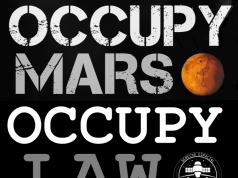Compartimos un interesante artículo publicado en The Harvard Law & Policy Review (HLPR).
By Robert Seaney and Jake Glendenning*
These past couple of weeks have been exciting for those interested in the future of space. Astronaut Scott Kelly returned to earth after a record-setting year-long stint in the International Space Station, and SpaceX attempted their fifth rocket landing, with mixed yet valuable results. Given these two significant milestones in one week, one thing is clear: Space is the future, and it is approaching rapidly. As with any rapidly advancing technology, it is important to develop and fine-tune a legal/policy infrastructure to facilitate growth and set clear rules for fledgling companies like SpaceX to preemptively avoid unexpected negative consequences to the greatest extent possible.
In a rare display of bipartisanship, Congress recently passed the Commercial Space Launch Competitiveness Act, which President Obama signed into law on November 25, 2015. While the bill’s genealogy is in itself fascinating, media coverage has largely centered on one controversial provision, Section 402 of Title IV, which establishes a legal infrastructure for asteroid mining. Garnering investments from entrepreneurs ranging from Google’s Larry Page to film director James Cameron, asteroid mining is quickly revealing its potential to become a trillion dollar industry.
The reason the Act is lauded by the fledgling asteroid mining industry is the same reason it is so controversial. Section 402 of the act aims to allow private citizens of the United States to own resources extracted from celestial bodies, such as an asteroid or the moon. It declares “the right of United States citizens to engage in commercial explorations for and commercial recovery of space resources free from harmful interference, in accordance with the international obligations of the United States and subject to authorization and continuing supervision by the Federal Government.”
For years preceding the bill’s passage, questions circulated about the legality of such a provision in light of the 1967 Outer Space Treaty.Modeled after the Antarctic Treaty, which prohibited sovereign claims to the world’s one uninhabited continent, Article II of the Outer Space Treaty prohibits sovereign claims to celestial bodies. It states “[o]uter space, including the Moon and other celestial bodies, is not subject to national appropriation by claim of sovereignty, by means of use or occupation, or by any other means.” The Commercial Space Act intuitively seems at odds with this rule, and attempts to sidestep it by stating “[the] United States does not assert sovereignty or sovereign or exclusive rights or jurisdiction over, or the ownership of, any celestial body.”
This simple declaration may not be enough to placate critics, however. A recent position paper on space resource mining by the International Institute of Space Law concluded that “it is still an open question whether this legal situation is satisfactory.” The paper finds that other countries’ interpretations of the Treaty may vary, and that there is not yet a consensus on how to manage other countries’ companies if said companies pursue the same resources. If a government plays a role in protection, that may be interpreted as a claim to sovereignty.
Some experts in the field are not waiting to find out whether other countries’ interpretations are in line with that of the U.S. to critique the act. According to Dr. Gbenga Oduntan, Senior lecturer in international commercial law at the University of Kent, the Act “is out of line with the letter and spirit of space law, which are based on common ownership by mankind.” A potential counter to this claim is that the Outer Space Treaty was designed primarily to prevent the weaponization of space, and that the acquisition of resources in space is not only consistent with the treaty, but has already been happening in the form of utilizing solar radiation and gravity. A distinction could be drawn between these resources already in use and finite resources such as water and metals, but in the nigh infinite vacuum of space, resources would also be near infinite as our technological reach continued to grow. These are just a few yet explored lines of argumentation in the budding field of space law.
Although some, like Dr. Oduntan, are critical of the act, Planetary Resources, the company with which James Cameron and Larry Page are involved, had great things to say about the Commercial Space Launch Competitiveness Act when it was signed, calling it “the single greatest recognition of property rights in history.” In a public statement, they continued: “This legislation establishes the same supportive framework that created the great economies of history, and will encourage the sustained development of space.” Their excitement about the act may seem a bit dramatic at first, but makes sense after understanding the potential return on investment for the industry.
Peter Diamandis, one of Fortune Magazine’s 50 Greatest Leaders in the World, famously said, “there are twenty-trillion-dollar checks up there, waiting to be cashed!” The idea that the first trillionaires among us will obtain their fortunes from space is nothing new. In the book “Mining The Sky: Untold Riches from the Asteroids, Comets, and Planets” author John S. Lewis estimates the value of one nearby orbiting asteroid to be over $20 trillion dollars in platinum-group and rare earth metals. Lewis also argues that space-mining is a unique enterprise in that it is both potentially profitable and consistent with efforts to mitigate damage from climate change. Looking to space could help us on earth resolve the challenges associated with scaling up green energy technologies such as wind and solar, which require large amounts of rare earth metals.
Given the current state of the earth’s climate, some scientists are looking to the asteroid mining industry for more radical solutions. A group of scientists from Scotland, in 2012, referenced the space mining industry as one way to implement a radical geoengineering initiative to use asteroid dust to shade the earth. According to the team’s calculations, asteroids would need to be transferred close to the earth’s orbit, which Planetary Resources claims it will be able to do by 2025. From earth’s orbit, they believe it would be possible to produce enough dust to decrease solar radiation hitting the earth by 1.7%, which would be enough to “offset the effects of a global increase in temperature of 3.6 degrees F.”
According to others, metals may not be the best initial target for space mining companies. Given the questions of feasibility surrounding the return of metals to earth, other types of resources will likely be targeted first. Water may actually be the most readily obtainable resource, and it will be essential as a fuel for spacecraft as involvement in space continues to grow. Using simple processes we can separate water into hydrogen and oxygen, both of which are essential for rocket propellant in space. As space exploration develops, it will be necessary to have fuel, and it is extremely cost prohibitive to use the water available on earth due to its weight. At a metric tonne per cubic meter, it would be significantly cheaper to extract water from asteroids, or even comets, than to carry it from earth.
The question of what resources will be mined first is far from the only one. There are still many legal questions that haven’t been explored. When can a mining company make a legal claim to the resources on a given asteroid? Some speculate that the claim may be upon discovery of the resources, while others think they must be physically possessed to be categorized as legal property. Is it legal to land on an asteroid that another company has researched and redirected closer to the earth? Can an entire asteroid be considered property, or can only the resources from said asteroid be claimed? Questions about the legal infrastructure of space exploration, much like the subject matter they apply to, seem nearly infinite now, but the industry seems to be growing rapidly enough to warrant serious attention.
*Robert Seaney is a 1L at Harvard Law School. Jake Glendenning is a UC Berkeley graduate employed at Google.





